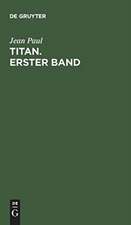The Routledge Handbook of Semiosis and the Brain: Routledge Handbooks in Linguistics
Editat de Adolfo M. García, Agustín Ibáñezen Limba Engleză Paperback – 26 aug 2024
Across individual and interpersonal settings, meaning is influenced by external and internal processes bridging phenomenological and biological dimensions. Yet, each of these dyads has been segregated into discipline-specific topics, with attempts to chart their intersections proving preliminary at best. Bringing together perspectives from world-leading experts, this volume seeks to overcome these disciplinary divides between the social and the natural sciences at both the empirical and theoretical levels. Its various chapters chart the foundations of neurosemiotics; characterize linguistic and interpersonal dynamics as shaped by neurocognitive, bodily, situational, and societal factors; and examine other daily neurosemiotic occurrences driven by faces, music, tools, and even visceral signals.
This comprehensive volume is a state-of the-art resource for students and researchers interested in how humans and other animals construe experience in such fields as cognitive neuroscience, biosemiotics, philosophy of mind, neuropsychology, neurolinguistics, and evolutionary biology.
| Toate formatele și edițiile | Preț | Express |
|---|---|---|
| Paperback (1) | 345.15 lei 3-5 săpt. | +35.73 lei 6-10 zile |
| Taylor & Francis – 26 aug 2024 | 345.15 lei 3-5 săpt. | +35.73 lei 6-10 zile |
| Hardback (1) | 1354.54 lei 3-5 săpt. | +50.24 lei 6-10 zile |
| Taylor & Francis – 14 noi 2022 | 1354.54 lei 3-5 săpt. | +50.24 lei 6-10 zile |
Din seria Routledge Handbooks in Linguistics
-
 Preț: 349.09 lei
Preț: 349.09 lei -
 Preț: 348.06 lei
Preț: 348.06 lei - 9%
 Preț: 1604.94 lei
Preț: 1604.94 lei -
 Preț: 347.98 lei
Preț: 347.98 lei - 18%
 Preț: 1567.34 lei
Preț: 1567.34 lei - 25%
 Preț: 1225.52 lei
Preț: 1225.52 lei - 18%
 Preț: 1563.50 lei
Preț: 1563.50 lei -
 Preț: 456.67 lei
Preț: 456.67 lei -
 Preț: 344.90 lei
Preț: 344.90 lei -
 Preț: 507.82 lei
Preț: 507.82 lei -
 Preț: 349.09 lei
Preț: 349.09 lei - 26%
 Preț: 1216.10 lei
Preț: 1216.10 lei - 18%
 Preț: 1567.34 lei
Preț: 1567.34 lei -
 Preț: 402.17 lei
Preț: 402.17 lei - 25%
 Preț: 1360.15 lei
Preț: 1360.15 lei -
 Preț: 416.22 lei
Preț: 416.22 lei - 25%
 Preț: 1268.81 lei
Preț: 1268.81 lei -
 Preț: 454.04 lei
Preț: 454.04 lei -
 Preț: 447.24 lei
Preț: 447.24 lei - 25%
 Preț: 1220.97 lei
Preț: 1220.97 lei -
 Preț: 346.69 lei
Preț: 346.69 lei -
 Preț: 435.49 lei
Preț: 435.49 lei -
 Preț: 446.08 lei
Preț: 446.08 lei - 25%
 Preț: 1234.70 lei
Preț: 1234.70 lei - 18%
 Preț: 1585.78 lei
Preț: 1585.78 lei -
 Preț: 453.78 lei
Preț: 453.78 lei - 18%
 Preț: 1404.80 lei
Preț: 1404.80 lei - 25%
 Preț: 1255.14 lei
Preț: 1255.14 lei - 11%
 Preț: 310.62 lei
Preț: 310.62 lei - 18%
 Preț: 1570.12 lei
Preț: 1570.12 lei - 25%
 Preț: 1191.21 lei
Preț: 1191.21 lei - 18%
 Preț: 1585.43 lei
Preț: 1585.43 lei - 25%
 Preț: 1221.19 lei
Preț: 1221.19 lei
Preț: 345.15 lei
Nou
Puncte Express: 518
Preț estimativ în valută:
66.05€ • 68.24$ • 54.97£
66.05€ • 68.24$ • 54.97£
Carte disponibilă
Livrare economică 05-19 martie
Livrare express 18-22 februarie pentru 45.72 lei
Preluare comenzi: 021 569.72.76
Specificații
ISBN-13: 9781032355610
ISBN-10: 1032355611
Pagini: 430
Ilustrații: 114
Dimensiuni: 178 x 254 x 31 mm
Greutate: 0.79 kg
Ediția:1
Editura: Taylor & Francis
Colecția Routledge
Seria Routledge Handbooks in Linguistics
Locul publicării:Oxford, United Kingdom
ISBN-10: 1032355611
Pagini: 430
Ilustrații: 114
Dimensiuni: 178 x 254 x 31 mm
Greutate: 0.79 kg
Ediția:1
Editura: Taylor & Francis
Colecția Routledge
Seria Routledge Handbooks in Linguistics
Locul publicării:Oxford, United Kingdom
Public țintă
Academic and PostgraduateRecenzii
Human culture is about shared meaning and its communication. Nothing quite shapes the human brain like culture and its associated varieties of meaning. Yet neuroscience has been mute about the issue and crippled by such omission. This remarkable book is a major advance towards bridging the ‘two cultures’ gap identified by CP Snow in 1959, through a mutually-beneficial dialogue between science and the humanities.
- Ian Robertson | Emeritus Professor of Psychology at Trinity College Dublin and Co-Director of the Global Brain Health Institute (Trinity College Dublin & UCSF, Dublin & San Francisco)
This timely book, which is a comprehensive, cross-disciplinary, and up-to-date exposition of the neural bases of semiosis, contains important contributions from a range of well-known and up-and-coming authors. I believe it will be useful to a wide audience, including students and researchers from various fields.
- Michael Ullman | Professor of Neuroscience, Georgetown University
By taking a multidisciplinary view of language, cognition, physiology, and culture, new insights about the world we live in can be revealed. The brain, a biological organ that both perceives and generates culture, is the ultimate integrative tool for understanding the complexity of sensemaking across our social and creative world. This unique book is a comprehensive and exciting analysis of neurosemiotics from multiple perspectives to help us better understand ourselves and the world we inhabit.
- Bruce L. Miller, MD | A.W. and Mary Margaret Clausen Distinguished Professor in Neurology; Director, Memory and Aging Center, UCSF; Co-Director, Global Brain Health Institute
Professors García and Ibáñez have put together an impressive array of leading edge knowledge of the neurology of sensemaking. To paraphrase Yeats, how can we separate the dance from the dancer? In this volume, no attempt at separation is made. In fact, with our growing knowledge of neurology we are beginning to perceive nothing less than the blueprints of the soul. This book marks an important milestone in understanding what it means to be human.
- Christopher Bailey | Arts and Health Lead, World Health Organization
- Ian Robertson | Emeritus Professor of Psychology at Trinity College Dublin and Co-Director of the Global Brain Health Institute (Trinity College Dublin & UCSF, Dublin & San Francisco)
This timely book, which is a comprehensive, cross-disciplinary, and up-to-date exposition of the neural bases of semiosis, contains important contributions from a range of well-known and up-and-coming authors. I believe it will be useful to a wide audience, including students and researchers from various fields.
- Michael Ullman | Professor of Neuroscience, Georgetown University
By taking a multidisciplinary view of language, cognition, physiology, and culture, new insights about the world we live in can be revealed. The brain, a biological organ that both perceives and generates culture, is the ultimate integrative tool for understanding the complexity of sensemaking across our social and creative world. This unique book is a comprehensive and exciting analysis of neurosemiotics from multiple perspectives to help us better understand ourselves and the world we inhabit.
- Bruce L. Miller, MD | A.W. and Mary Margaret Clausen Distinguished Professor in Neurology; Director, Memory and Aging Center, UCSF; Co-Director, Global Brain Health Institute
Professors García and Ibáñez have put together an impressive array of leading edge knowledge of the neurology of sensemaking. To paraphrase Yeats, how can we separate the dance from the dancer? In this volume, no attempt at separation is made. In fact, with our growing knowledge of neurology we are beginning to perceive nothing less than the blueprints of the soul. This book marks an important milestone in understanding what it means to be human.
- Christopher Bailey | Arts and Health Lead, World Health Organization
Cuprins
Acknowledgements
Semiosis, brain, and context: The unmet need for a transdisciplinary framework (A. M. García & A. Ibáñez)
PART 1: PROLEGOMENA TO NEUROSEMIOTICS
1. Neurosemiotics: A brief history of its development and key concerns (K. Kull & D. Favareau)
2. Steps to a semiotic cognitive neuroscience (T. Deacon)
3. An active inference approach to semiotics: A variational theory of signs (A. Milette-Gagnon, S. P. L. Veissière, K. J. Friston, & M. J. D. Ramstead)
4. Experimental semiotics: Past, present, and future (J. Nölle & B. Galantucci)
5. Beyond the human animal: Towards a cross-species neurosemiotics (M. Tønnessen)
PART 2: LANGUAGE AND ITS PATHWAYS TO MEANING
6. Neural bases of multimodal semantics (M. Visser)
7. Embodied mechanisms and the shaping of semantics (G. Buccino)
8. The figurative brain (V. Cuccio)
9. Pharmacological modulation of meaning attribution (E. Tagliazucchi)
10. How grammar means (M. de Vega)
11. Discourse and the brain: Capturing meaning in the wild (N. Riccardi & R. H. Desai)
12. Words, meanings, and the bilingual brain (N. del Maschio, J. Abutalebi, & D. Perani)
13. How do sign languages mean? (R. Campbell)
PART 3: THE NEUROSEMIOTICS OF SOCIAL DYNAMICS
14. Empathy, meaning, and the human brain (K. Lehmann & P. Kanske)
15. Biological bases of moral cognition and their role in the construal of meaning (S. Baez)
16. The neurosemiotics of social interaction: Insights from second-person neuroscience (L. Schilbach)
17. Joint epistemic engineering: The neglected process in human communication (A. Stolk, J. Bašnáková, & I. Toni)
18. Towards a neurosemiotics of friendship (C. Emmeche)
19. Neurosemiotics and ideology: A linguistic view (A. Lukin & D. Butt)
20. The interplay of culture, religion, and biology (J. Y. Sasaki & H. I. Pearson)
PART 4: FURTHER SEMIOTIC DOMAINS
21. What makes us human? Face identity recognition (B. Rossion)
22. Musical signs and the human organism (A. M. Belfi)
23. The meaning of tools: The pragmatic value of semantic knowledge (F. Osiurak, J. Baumard, C. Merck, & M. Lesourd)
24. Interpreting the signals within: Meaning and prediction during interoception (R. Smith & S. S. Khalsa)
25. The hierarchical semantics of self (G. Northoff & D. Gorini)
Semiosis, brain, and context: The unmet need for a transdisciplinary framework (A. M. García & A. Ibáñez)
PART 1: PROLEGOMENA TO NEUROSEMIOTICS
1. Neurosemiotics: A brief history of its development and key concerns (K. Kull & D. Favareau)
2. Steps to a semiotic cognitive neuroscience (T. Deacon)
3. An active inference approach to semiotics: A variational theory of signs (A. Milette-Gagnon, S. P. L. Veissière, K. J. Friston, & M. J. D. Ramstead)
4. Experimental semiotics: Past, present, and future (J. Nölle & B. Galantucci)
5. Beyond the human animal: Towards a cross-species neurosemiotics (M. Tønnessen)
PART 2: LANGUAGE AND ITS PATHWAYS TO MEANING
6. Neural bases of multimodal semantics (M. Visser)
7. Embodied mechanisms and the shaping of semantics (G. Buccino)
8. The figurative brain (V. Cuccio)
9. Pharmacological modulation of meaning attribution (E. Tagliazucchi)
10. How grammar means (M. de Vega)
11. Discourse and the brain: Capturing meaning in the wild (N. Riccardi & R. H. Desai)
12. Words, meanings, and the bilingual brain (N. del Maschio, J. Abutalebi, & D. Perani)
13. How do sign languages mean? (R. Campbell)
PART 3: THE NEUROSEMIOTICS OF SOCIAL DYNAMICS
14. Empathy, meaning, and the human brain (K. Lehmann & P. Kanske)
15. Biological bases of moral cognition and their role in the construal of meaning (S. Baez)
16. The neurosemiotics of social interaction: Insights from second-person neuroscience (L. Schilbach)
17. Joint epistemic engineering: The neglected process in human communication (A. Stolk, J. Bašnáková, & I. Toni)
18. Towards a neurosemiotics of friendship (C. Emmeche)
19. Neurosemiotics and ideology: A linguistic view (A. Lukin & D. Butt)
20. The interplay of culture, religion, and biology (J. Y. Sasaki & H. I. Pearson)
PART 4: FURTHER SEMIOTIC DOMAINS
21. What makes us human? Face identity recognition (B. Rossion)
22. Musical signs and the human organism (A. M. Belfi)
23. The meaning of tools: The pragmatic value of semantic knowledge (F. Osiurak, J. Baumard, C. Merck, & M. Lesourd)
24. Interpreting the signals within: Meaning and prediction during interoception (R. Smith & S. S. Khalsa)
25. The hierarchical semantics of self (G. Northoff & D. Gorini)
Notă biografică
Adolfo M. García specializes in the neuroscience of language and communication. He serves as Director of the Cognitive Neuroscience Center (UdeSA, Argentina), Senior Atlantic Fellow at the Global Brain Health Institute (UCSF, USA), Associate Researcher at USACH (Chile), Director of Language Science at Redenlab, and Researcher at CONICET (Argentina). Dr. García leads research projects in more than ten countries across the globe. He has more than 200 publications, including works in top ten journals. His scientific contributions have been recognized by various awards and distinctions.
Agustín Ibáñez works on global approaches to dementia and social, cognitive, and affective neuroscience. He is Director of the Latin American Brain Health Institute (BrainLat) and Full Professor at the CSCN (Universidad Adolfo Ibáñez, Chile); and Associate Research Professor and Group Leader of Predictive Brain Health Modelling Group (TCD, Ireland). Dr Ibáñez has over 300 publications, including works in top ten journals. His intense work has helped Latin American translational neuroscience by establishing a framework to engage scientists through internships, workshops, master’s and PhD programs, organizing educational activities for the health community, and focusing
on cognitive neuroscience, among others.
Agustín Ibáñez works on global approaches to dementia and social, cognitive, and affective neuroscience. He is Director of the Latin American Brain Health Institute (BrainLat) and Full Professor at the CSCN (Universidad Adolfo Ibáñez, Chile); and Associate Research Professor and Group Leader of Predictive Brain Health Modelling Group (TCD, Ireland). Dr Ibáñez has over 300 publications, including works in top ten journals. His intense work has helped Latin American translational neuroscience by establishing a framework to engage scientists through internships, workshops, master’s and PhD programs, organizing educational activities for the health community, and focusing
on cognitive neuroscience, among others.
Descriere
This handbook introduces neurosemiotics, a pluralistic framework to reconsider semiosis as an emergent phenomenon at the interface of biology and culture.





















